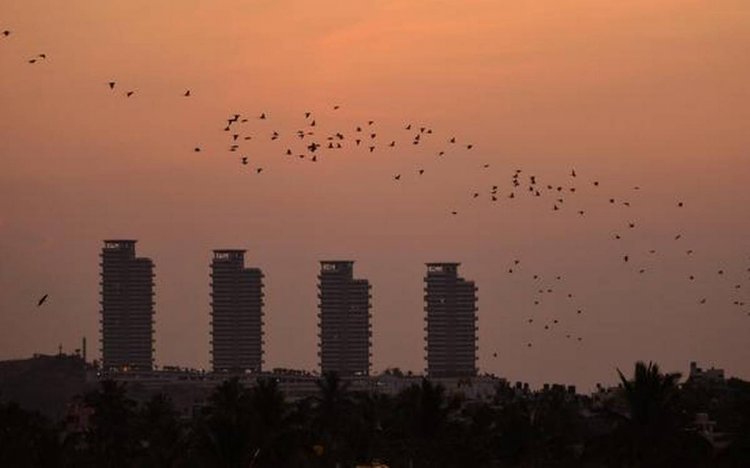COVID-19 lockdown-like interventions may help combat air pollution in India, say scientists

New Delhi: The lockdowns enforced due to the COVID-19 pandemic led to large improvement in air quality in India, say scientists who suggest that such interventions may be used as a possible emergency measure to combat severe air pollution episodes like those witnessed in Delhi-NCR region during the winter months.
Ahead of the World Environment Day on June 5, experts have outlined several environmental factors that saw improvements in India as a result of the lockdowns, namely air quality, noise pollution, water quality, and biodiversity among others due to reduced industrial and human activities.
On March 24, the Union government ordered a nationwide lockdown for 21 days, limiting the movement of people in India as a preventive measure against the COVID-19 pandemic.
Since then the lockdown has been extended many times with gradual lifting of restrictions.
"There is a large improvement in air quality, especially in urban areas -- from alarming or poor to satisfactory or good. The main reason is reduced human activities," said S K Satheesh, Professor at Centre for Atmospheric & Oceanic Sciences, Indian Institute of Science (IISc) Bangalore.
"On average, reduction in particulate matter (PM) concentrations over southern part of India is around 50 to 60 percent, and over the Indo-Gangetic basin, including Delhi, UP, Bihar, West Bengal etc it is as much as 75 percent," he told PTI.
Satheesh noted that the major contributing factors of pollution are transport vehicles, industries, crop-residue burning, waste burning and so on.
He explained that in cities, more than half of the air pollution is caused due to vehicular emissions, adding that during the lockdown, there was a large reduction in the number of vehicles on road.
According to two studies, published in the journal Geophysical Research Letters in May, the levels of two major air pollutants, including nitrogen dioxide, drastically reduced since lockdowns were enforced worldwide in response to the COVID-19 pandemic.
In India, satellite data has shown a significant drop in particulate matter or aerosol levels after the COVID-19 lockdown over most parts of the country, Satheesh said.
"Our field measurements show that there is a substantial reduction in the concentration of suspended particulate matter (PM), a major component of air pollution, in the atmosphere due to reduced human activities as a consequence of the lockdown," he said.
The scientist explained that multi-spectral measurements of aerosol absorption, in addition to data available from Central Pollution Control Board (CPCB), indicate that the drastic decrease in pollution levels is mainly due to a reduction in fossil fuel burning emissions.
Manish Kumar Singh, Assistant Professor, Earth Sciences, Indian Institute of Technology (IIT) Gandhinagar agreed with Satheesh, adding such lockdown measures can be used in the future to combat pollution.
"In my opinion, the kind of recovery shown by mother nature during the lockdown, there is no harm in using lockdown as a possible emergency measure to combat severe air pollution episodes like we witness in Delhi winters," Kumar told PTI.
"Similarly, industrial effluent tracing is possible by episodal closure and opening to recognize the impact on water resources," he said.
Environmental Engineer Bose K Varghese noted that when the lockdown came into effect, nobody was really thinking about the environment as people were staring at the direct fallout of a complete lockdown.
"As days went by and we struggled with getting used to life indoors, we started noticing the environment around us transforming in palpable ways," said Varghese, Head of Green Initiatives at Infosys Limited, which won the UN Global Climate Action Award at COP25 climate conference in Spain in December last.
"The most noticeable effects are cleaner air, cleaner water, less waste, very low noise levels, and the wildlife that came out of hiding," said Varghese.
He explained that while the real extent of the effect of COVID-19 on the environment is not known yet, the effects witnessed can easily be explained by a cause-and-effect analysis.
According to Satheesh, lockdown measures may not only help reduce pollution levels, but also have an impact on the upcoming monsoon, however, it is too early to make a conclusive statement.
Based on earlier studies, he believes that atmospheric aerosols have a crucial role in determining the onset date of monsoon, and also the distribution of monsoon rainfall across India.
Varghese noted that the lockdown has also resulted in effects that people cannot see, like the gradual repair of the ozone hole.
Large reduction in air-traffic resulted in a significant reduction in particulate matter and greenhouse gas emissions in the upper atmosphere, some of which are already shown to impact the stratospheric ozone layer through self-lofting of these pollutants emitted by airplanes, Satheesh explained.
Large reduction in airplane emissions would further the recovery of ozone hole, which is already taking place, he said.
Varghese noted that when COVID-19 fears recede, things are expected to quickly go back to normal, however, it is hoped that people will retain some of the lifestyle changes that are beneficial to the environment.
"The undeniable benefit of this outbreak is that it showed us a better future that we all want to embrace. It gave us a preview of an environment that we all aspire to live in," he added.
- By Shakoor Rather















































